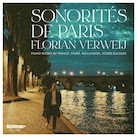

Florian Verweij: Sonorités de Paris
Gutman Records
In fashioning his debut album around piano music associated with the Belle Époque (1871-1914), Dutch pianist Florian Verweij (b. 1997) could have assembled a set-list featuring Ravel, Debussy, Fauré, and Franck. Yet while selections by the latter pair do grace his eighty-minute collection, to his credit Verweij made less predictable choices when it came to completing the programme. In an inspired move, he elected to couple pieces by Gabriel Fauré (1845-1924) and César Franck (1822-90) with ones by Lili Boulanger (1893-1918) and, most importantly, the unjustly neglected Jean Roger-Ducasse (1873-1954).
It was hearing Franck's Prélude, aria et final, the composer's last major work for solo piano, that triggered the French concept for Verweij's first album, but after deciding on Franck's he faced the challenge of selecting others to go with it. Upon discovering Roger-Ducasse's captivating Sonorités…. [sic] and learning that his music is rarely played and that he was friends with his teacher, Gabriel Fauré, and the young Boulanger, Verweij's choices were set. Interestingly, the composers span four distinct generations and thus provide an enlightening overview of French piano music across many decades. From Fauré's Romances sans paroles (1863) and Franck's 1887 work we jump to Boulanger's Thème et variations (1914) and six Roger-Ducasse works written between 1907 and 1921. As a musician, Verweij's intelligence, poise, lucid grasp, and virtuosic technique are drawn upon for the album's poetic and nuanced renditions. What also distinguishes his playing on Sonorités de Paris is the passion he brings to the performances, an energy that illuminates the material and makes it seem as if it's being discovered in the moment. Verweij, who completed his bachelor's (2020) and master's (2023) degrees with the highest distinction at the Amsterdam Conservatory, has already won multiple awards for his piano artistry.
When the pianist first heard works by Fauré's favourite composition student, Roger-Ducasse, they struck him “like a lightning bolt.” After listening to the pieces featured here, one might share with the young pianist mystification over why someone so gifted would have been overlooked. In the liner notes, different reasons are proposed, from the possibility that he was overshadowed by Fauré to complex writing that proved an impediment to popular acceptance. Regardless, Verweij has done him a great service in shining a fresh light on his material, in this case five single-movement pieces and 1907's 6 Préludes. Opening with Barcarolle no. 1 was a canny choice by the pianist when the rhapsodic setting is enrapturing and locates itself comfortably along the Impressionism spectrum. It also includes intensely dramatic passages, and it's these that grant Verweij a magnificent showcase for his dynamic side. Chant de l'aube instantly arrests the ear with bright flourishes and a rousing tone before pivoting to a dream-like central episode executed with sensitivity. Sonorités…. likewise oscillates between delicate expressions and intense declamations, with Verweij's deftly handled transitions making the contrasts seem less pronounced. Rythmes naturally includes its fair share of dance-like rhythmic figures, but it's the rippling cascades that make this ecstatic, almost mystical piece most worth hearing.
Fauré's exquisite Romances sans paroles follows, their gentle lyricism not unwelcome after the intensity of the Roger-Ducasse pieces. Written when the composer was only eighteen, the three elegant miniatures already exude the aromatic aura of Fauré's later works. The graceful flow of the second is pure Fauré, though it augments its sprinkling runs with animated streams of sixteenth notes too. The third is the most lyrical, however, and Verweij amplifies the quality with a beautifully calibrated treatment. Boulanger, who tragically died at twenty-four after succumbing to a lung condition that had plagued her since childhood, is represented by the haunting Thème et Variations, which at nine minutes makes up about half of her entire solo piano output. She began sketching the work in 1911 and completed it three years later, but it wasn't rediscovered until the ‘60s when it was found in one of her notebooks. The stark, almost anguished theme is full of foreboding that the variations build upon in plunging into darker waters and deepening the unsettling effect. Verweij appears to surrender completely to the work's tone, almost as if he's channeling the spirit of the composer.
Sonorités de Paris returns to Roger-Ducasse for two pieces before concluding with the work that inspired the project, Franck's Prélude, aria et final. First, however, there's Roger-Ducasse's disarmingly pretty Prélude d'un ballet, a short yet nonetheless memorable gem, and 6 Préludes, splendid miniatures all, be they lyrical (“Très calme”), animated (“D'un rythme très précis”), haunting (“Très libre”), or tender (“D'un rythme capricieux et tendre”). Weighing in at twenty-four minutes, Prélude, aria et final is no brief album coda but instead a substantial three-part work. The cantabile character of the “Prélude” captivates immediately, though it gradually leaves serenity behind for high intensity before calm's restored. The central “Aria” casts arguably the work's strongest spell in the serenity and dignity of its expression, qualities brought fully to the fore in the pianist's delicate rendering. At recording's end, Verweij enlivens the volcanic “Final” with a stunning performance.
Recorded at Muziekcentrum van de Omroep in July 2024, Sonorités de Paris sounds great and looks terrific too, with the Gutman label having given Verweij's debut the deluxe treatment. The physical package captures the Romantic glory of Paris in photographs, and the twenty-eight-page booklet enhances the release with commentaries and extra photos. What recommends the release most, of course, is Verweij's playing as well as his inspired inclusion of Boulanger and especially Roger-Ducasse. It's interesting that in a 1921 profile musicologist Alfred J. Swan referred to Roger-Ducasse's “abundantly rich imagination, clear and deep thought, graceful and precise workmanship, and an unerring taste” when, given the evidence at hand, the same words could be applied to Verweij.February 2025